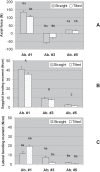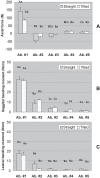Effect of the number of abutments on biomechanics of Branemark prosthesis with straight and tilted distal implants
- PMID: 20485930
- PMCID: PMC5349755
- DOI: 10.1590/s1678-77572010000200013
Effect of the number of abutments on biomechanics of Branemark prosthesis with straight and tilted distal implants
Abstract
Objective: This study aimed to evaluate the bending moments, and compressive and tensile forces in implant-supported prostheses with three, four or five abutments.
Material and methods: Ten Pd-Ag frameworks were tested over two master models with: 1) parallel vertical implants, and 2) tilted distal implants. Strain gauges were fixed on the abutments of each master model to measure the deformation when a static load of 50 N was applied on the cantilever (15 mm). The deformation values were measured when the metallic frameworks were tested over three, four or five abutments, and transformed into force and bending moment values. Data were analyzed by ANOVA and Tukey's test for multiple comparisons at 5% level of significance.
Results: Abutment #1 (adjacent to the cantilever) had the highest values of force and sagittal bending moment for all tests with three, four or five abutments. Independently from the number of abutments, axial force in abutment #1 was higher in the vertical model than in the tilted model. Total moment was higher with three abutments than with four or five abutments. Independently from the inclination of implants, the mean force with four or five abutments was lower than that with three abutments.
Conclusion: The results suggest that in the set-ups with four or five abutments tilted distal implants reduced axial force and did not increase bending moments.
Figures






Similar articles
-
Biomechanical in vitro evaluation of two full-arch rehabilitations supported by four or five implants.Int J Oral Maxillofac Implants. 2015 Mar-Apr;30(2):419-26. doi: 10.11607/jomi.3767. Int J Oral Maxillofac Implants. 2015. PMID: 25830403
-
Biomechanical comparison of axial and tilted implants for mandibular full-arch fixed prostheses.Int J Oral Maxillofac Implants. 2011 Sep-Oct;26(5):976-84. Int J Oral Maxillofac Implants. 2011. PMID: 22010079
-
Evaluation of strain at the terminal abutment site of a fixed mandibular implant prosthesis during cantilever loading.J Prosthodont. 1993 Jun;2(2):93-102. doi: 10.1111/j.1532-849x.1993.tb00389.x. J Prosthodont. 1993. PMID: 8242172
-
The influence of functional forces on the biomechanics of implant-supported prostheses--a review.J Dent. 2002 Sep-Nov;30(7-8):271-82. doi: 10.1016/s0300-5712(02)00065-9. J Dent. 2002. PMID: 12554107 Review.
-
Cantilever and implant biomechanics: a review of the literature. Part 1.J Prosthodont. 1994 Mar;3(1):41-6. doi: 10.1111/j.1532-849x.1994.tb00124.x. J Prosthodont. 1994. PMID: 8061790 Review.
Cited by
-
All-on-4 Hybrid with Extra-Long Transnasal Implants: Descriptions of the Technique and Short-Term Outcomes in Three Cases.J Clin Med. 2024 Jun 6;13(11):3348. doi: 10.3390/jcm13113348. J Clin Med. 2024. PMID: 38893060 Free PMC article.
-
Effect of veneering material on the deformation suffered by implant-supported fixed prosthesis framework.J Appl Oral Sci. 2014 Jun;22(3):209-17. doi: 10.1590/1678-775720130517. J Appl Oral Sci. 2014. PMID: 25025562 Free PMC article.
References
-
- Aparicio C, Perales P, Rangert B. Tilted implants as an alternative to maxillary sinus grafting: a clinical, radiologic, and periotest study. Clin Implant Dent Relat Res. 2001;3:39–49. - PubMed
-
- Bellini CM, Romeo D, Galbusera F, Taschieri S, Raimondi MT, Zampelis A, et al. Comparison of tilted versus nontilted implantsupported prosthetic designs for the restoration of the edentuous mandible: a biomechanical study. Int J Oral Maxillofac Implants. 2009;24:511–517. - PubMed
-
- Bevilacqua M, Tealdo T, Pera F, Menini M, Mossolov A, Drago C, et al. Three-dimensional finite element analysis of load transmission using different implant inclinations and cantilever lengths. Int J Prosthodont. 2008;21:539–542. - PubMed
-
- Branemark P-I, Engstrand P, Ohrnell L-O, Grondahl K, Nilsson P, Hagberg K, et al. Branemark Novum: a new treatment concept for rehabilitation of the edentulous mandible. Preliminary results from a prospective clinical follow-up study. Clin Implant Dent Relat Res. 1999;1:2–16. - PubMed
-
- Branemark P-I, Grondahl K, Ohrnell LO, Nilsson P, Petruson B, Svensson B, et al. Zygoma fixture in the management of advanced atrophy of the maxilla: technique and long-term results. Scand J Plast Reconstr Surg Hand Surg. 2004;38:70–85. - PubMed
Publication types
MeSH terms
Substances
LinkOut - more resources
Full Text Sources

